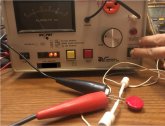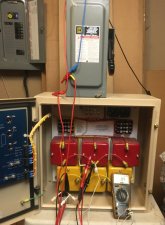Hedges
I See Electromagnetic Fields!
- Joined
- Mar 28, 2020
- Messages
- 20,504
Surge arrestors are used on AC and DC side of PV inverters for protection, to clamp high voltage transients.
One inverter I have (actually several) are in the SMA family SUNNY BOY 5000-US / 6000-US / 7000-US / 8000-US. These come with a kit of MOV to protect the DC side:

The MOVs are about 20mm in diameter, and the three are held in sockets, not wired in parallel but rather in a delta. I think one is across the PV input, and one from each of the PV inputs to chassis.
SMA manual says if damaged for for periodic maintenance in lightning-prone areas:
"replace all DC varistors:
Only use spare parts from SMA
• Always replace the entire set of DC varistors.
• Order number in Section 12 ”Spare Parts and Accessories” (page 101)."
They are conveniently devoid of any markings. Or more likely, SMA paid extra to get them unbranded.
I've got a HyPot, so I connected that and cranked up voltage until it tripped for 1 mA leakage. The three parts were all about 760 VRMS, more or less, which is 1075 V peak.


Not what I expected - thought it would be much closer to the 600 Voc max spec of the inverter.
Could be the following part, min voltage meets my measurement:
 www.digikey.com
www.digikey.com
Or this one, typical voltage matches (but color is differnt):
 www.digikey.com
www.digikey.com
These are recommended for 970VDC or 895VDC, would have expected something lower.
I plan to add more, rated for lower voltage and higher energy.
One inverter I have (actually several) are in the SMA family SUNNY BOY 5000-US / 6000-US / 7000-US / 8000-US. These come with a kit of MOV to protect the DC side:

The MOVs are about 20mm in diameter, and the three are held in sockets, not wired in parallel but rather in a delta. I think one is across the PV input, and one from each of the PV inputs to chassis.
SMA manual says if damaged for for periodic maintenance in lightning-prone areas:
"replace all DC varistors:
Only use spare parts from SMA
• Always replace the entire set of DC varistors.
• Order number in Section 12 ”Spare Parts and Accessories” (page 101)."
They are conveniently devoid of any markings. Or more likely, SMA paid extra to get them unbranded.
I've got a HyPot, so I connected that and cranked up voltage until it tripped for 1 mA leakage. The three parts were all about 760 VRMS, more or less, which is 1075 V peak.


Not what I expected - thought it would be much closer to the 600 Voc max spec of the inverter.
Could be the following part, min voltage meets my measurement:
TMOV20RP750E Littelfuse Inc. | Circuit Protection | DigiKey
Order today, ships today. TMOV20RP750E – 1.2 kV 10 kA Varistor 1 Circuit Through Hole Disc 20mm from Littelfuse Inc.. Pricing and Availability on millions of electronic components from Digi-Key Electronics.
Or this one, typical voltage matches (but color is differnt):
ERZ-V20D112 Panasonic Electronic Components | Circuit Protection | DigiKey
Order today, ships today. ERZ-V20D112 – 1.1 kV 7.5 kA Varistor 1 Circuit Through Hole Disc 22.50mm from Panasonic Electronic Components. Pricing and Availability on millions of electronic components from Digi-Key Electronics.
These are recommended for 970VDC or 895VDC, would have expected something lower.
I plan to add more, rated for lower voltage and higher energy.





